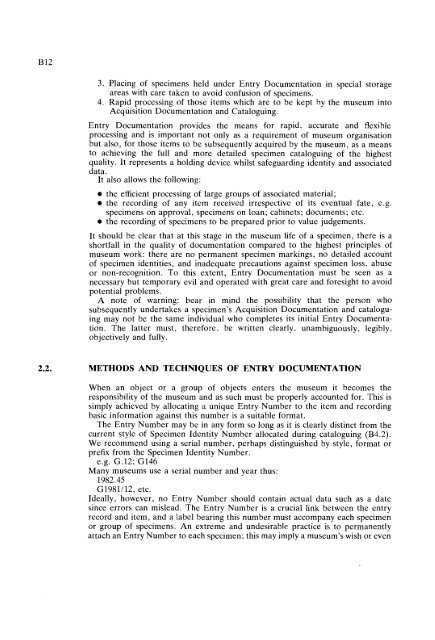GUIDELINES FOR THE CURATION OF GEOLOGICAL MATERIALS
GUIDELINES FOR THE CURATION OF GEOLOGICAL MATERIALS
GUIDELINES FOR THE CURATION OF GEOLOGICAL MATERIALS
You also want an ePaper? Increase the reach of your titles
YUMPU automatically turns print PDFs into web optimized ePapers that Google loves.
3. Placing of specimens held under Entry Documentation in special storage<br />
areas with care taken to avoid confusion of specimens.<br />
4. Rapid processing of those items which are to be kept by the museum into<br />
Acquisition Documentation and Cataloguing.<br />
Entry Documentation provides the means for rapid, accurate and flexible<br />
processing and is important not only as a requirement of museum organisation<br />
but also, for those items to be subsequently acquired by the museum, as a means<br />
to achieving the full and more detailed specimen cataloguing of the highest<br />
quality. It represents a holding device whilst safeguarding identity and associated<br />
data.<br />
It also allows the following:<br />
the efficient processing of large groups of associated material;<br />
the recording of any item received irrespective of its eventual fate, e.g.<br />
specimens on approval, specimens on loan; cabinets; documents; etc.<br />
the recording of specimens to be prepared prior to value judgements.<br />
It should be clear that at this stage in the museum life of a specimen, there is a<br />
shortfall in the quality of documentation compared to the highest principles of<br />
museum work: there are no permanent specimen markings, no detailed account<br />
of specimen identities, and inadequate precautions against specimen loss. abuse<br />
or non-recognition. To this extent, Entry Documentation must be seen as a<br />
necessary but temporary evil and operated with great care and foresight to avoid<br />
potential problems.<br />
A note of warning: bear in mind the possibility that the person who<br />
subsequently undertakes a specimen's Acquisition Documentation and cataloguing<br />
may not be the same individual who completes its initial Entry Documentation.<br />
The latter must, therefore. be written clearly, unambiguously, legibly,<br />
objectively and fully.<br />
METHODS AND TECHNIQUES <strong>OF</strong> ENTRY DOCUMENTATION<br />
When an object or a group of objects enters the museum it becomes the<br />
responsibility of the museum and as such must be properly accounted for. This is<br />
simply achieved by allocating a unique Entry Number to the item and recording<br />
basic information against this number is a suitable format.<br />
The Entry Number may be in any form so long as it is clearly distinct from the<br />
current style of Specimen Identity Number allocated during cataloguing (B4.2).<br />
We recommend using a serial number, perhaps distinguished by style, format or<br />
prefix from the Specimen ldentity Number.<br />
e.g. G.12; G146<br />
Many museums use a serial number and year thus:<br />
1982.45<br />
G1981112, etc.<br />
Ideally, however, no Entry Number should contain actual data such as a date<br />
since errors can mislead. The Entry Number is a crucial link between the entry<br />
record and item, and a label bearing this number must accompany each specimen<br />
or group of specimens. An extreme and undesirable practice is to permanently<br />
attach an Entry Number to each specimen; this may imply a museum's wish or even

















